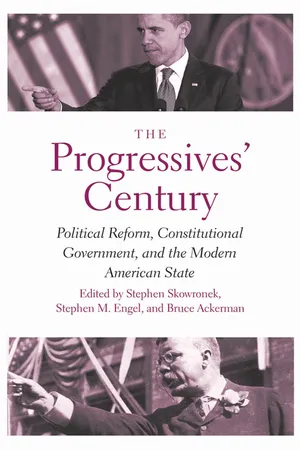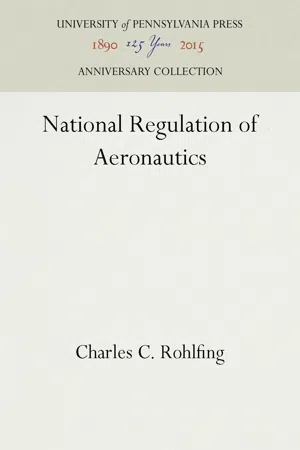Politics & International Relations
Interstate Commerce Act
The Interstate Commerce Act was a U.S. federal law enacted in 1887 to regulate the railroad industry and ensure fair and reasonable rates for shippers. It established the Interstate Commerce Commission (ICC) to oversee and enforce the regulations, marking the first time the federal government intervened in private business to promote the public interest. The Act laid the foundation for future government regulation of industry.
Written by Perlego with AI-assistance
Related key terms
1 of 5
3 Key excerpts on "Interstate Commerce Act"
- eBook - PDF
Who Owns the Sky?
The Struggle to Control Airspace from the Wright Brothers On
- Stuart Banner(Author)
- 2009(Publication Date)
- Harvard University Press(Publisher)
The Interstate Commerce Act of 1887, which placed various restrictions on the rates railroads could charge, would be interpreted very narrowly in its earliest years by the Supreme Court, but it was just the first in a long series of stat-utes in which the federal government would govern the railroad business. The Safety Appliance Act of 1893 required all trains to have power brakes and automatic couplers. The Elkins Act of 1903 and the Hepburn Act of 1906 further regulated rates. The Employers’ Liability Act of 1908 governed injuries suffered by railroad workers, and the Adamson Act of 1916 placed an upper limit on their hours and a lower limit on their wages. These stat-utes and others were all upheld by the Supreme Court as falling within Congress’s power over interstate commerce. 12 I N T E R S T A T E C O M M E R C E I N T H E A I R 143 The same pattern occurred with the invention of the telephone and the radio, two more intrinsically interstate technologies. Fed-eral regulation of the telephone industry began in 1910, when Congress added the telephone to the jurisdiction of the Interstate Commerce Commission. In the Radio Act of 1912, Congress re-quired broadcasters to obtain federal licenses and authorized the Commerce Department to regulate the airwaves. With each new form of transportation or communication, federal regulation fol-lowed. Indeed, as technology integrated the states into a single Ameri-can market, the federal government increasingly began regulating the markets themselves, not just the technology. - eBook - PDF
The Progressives' Century
Political Reform, Constitutional Government, and the Modern American State
- Stephen Skowronek, Stephen M. Engel, Bruce Ackerman(Authors)
- 2016(Publication Date)
- Yale University Press(Publisher)
The templates for the Motor Carrier Act of 1935 and, earlier, for the Pure Food and Drugs Act of 1906 were both set in interstate cooperation of regulators who considered model standards and model statutes. The governance of transportation markets saw the slow but steady exten-sion of state-level powers to federal-level governance. In the writing of the In-terstate Commerce Act of 1887, Congress looked to the transportation model of the Steamboat Act of 1852, which, as Mashaw argues, “anticipated the orga-nizational form, the practical operation, and the congressional politics of much modern health and safety regulation.” 34 To be sure, in its rate regulation the ICC departed from the earlier paradigms of steamboat governance. Yet it did not radically transcend the powers that state governments and commis-sions had exercised in their governance of railroads. The Illinois Constitution of 1870 and the regulatory arrangements created in 1873 had regulated rates through commission rate setting or (in other states) litigation-based enforce-ment (with, for example, triple damages). 35 Except for Stephen Skowronek’s treatment of the Transportation Act of 1920 and Lawrence Rothenberg’s study of interstate trucking, little attention has been paid to a set of developments that were equally important to the twentieth-century economic infrastructure of the United States: trucking and highways. 36 The development of horseless carriages and small-scale freight transportation on public roads introduced a competitive dynamic to the inter-state freight market and posed important challenges to state governments. For example, the expansion of individualized transportation was accompanied by a rise in the number of accidents. - eBook - PDF
- Charles C. Rohlfing(Author)
- 2016(Publication Date)
I I I T H E A I R C O M M E R C E A C T O F 1926. T H E D E V E L O P M E N T O F A D M I N I S T R A T I O N The Air Commerce Act of 1926 became a law on May 20, 1926. It represents the cumulative effort of many organizations to secure Federal action in the en-couragement and regulation of civil aeronautics. In its final form, the Air Commerce Act of 1926 was the result of the untiring efforts of Senator Bingham of Connecticut and Congressmen James S. Parker of New York, Schuyler Merritt of Connecticut, and Clarence F. Lea of California. 1 These men assumed the leadership in Congress in securing the final passage of Senate Bill 41. The Constitutional Basis of the Act The principal constitutional basis of the Air Com-merce Act of 1926 is Article I, section 8, clause 3. (Congress shall have the power to regulate commerce with foreign nations, and among the several states, and with the Indian tribes.) It is important to note that Article I, section 8, clause 17, and Article IV, section 3, clause 2, are also utilized to extend jurisdiction over the District of Columbia and the territories. A portion of the Air Commerce Act reads as follows: As used in this act, the term 'interstate or foreign 1 For a statement of the activities of these men see Aircraft Year Book, 1927, p. 5. 30 Air Commerce Act of 192Ó 31 air commerce' means air commerce between any State, Territory, or possession, or the District of Columbia, and any place outside thereof; or between points within the same State, Territory, or possession, or the District of Columbia, but through the airspace over any place outside thereof; or wholly within the airspace over any Territory or possession or the District of Columbia. 2 In addition to the three clauses cited above, there is an evident use of the war powers in section S-f of the act permitting the Secretary of War to designate military airways, and in section 4 the President is authorized to set aside airspace reservations.
Index pages curate the most relevant extracts from our library of academic textbooks. They’ve been created using an in-house natural language model (NLM), each adding context and meaning to key research topics.


